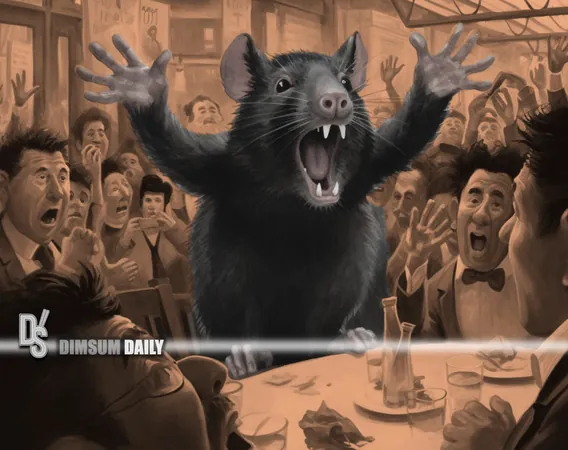
Shocking Revelations About Hong Kong’s Restaurant Hygiene: Are You Eating in a Pest-Infested Kitchen?
2025-04-03
Author: Lok
Shocking Revelations About Hong Kong’s Restaurant Hygiene: Are You Eating in a Pest-Infested Kitchen?
Hong Kong’s culinary landscape is celebrated for its eclectic mix of gourmet experiences, from the most exclusive Michelin-starred restaurants to local cha chaan tengs. However, lurking beneath this glittering exterior is a disturbing reality: rampant pest infestations that jeopardize public health and safety. Recent incidents, particularly one involving a rat in the kitchen of Cheung Hing Kee—a restaurant even recommended by Michelin—have ignited intense public outrage and compelling calls for urgent reforms in hygiene standards across the city.
The disturbing video footage of the rat casually roaming inside Cheung Hing Kee, located in the bustling Tsim Sha Tsui, has gone viral and serves as stark evidence of a broader problem. Social media was rife with reactions ranging from shock to sarcastic humor, with comments like “five-star rat” and “Michelin moment” underscoring a collective frustration with the growing number of pest-related incidents in dining establishments across Hong Kong.
Mr. Wong, the proprietor of Cheung Hing Kee, did acknowledge the pest issue but seemed to brush it off, stating, “Every restaurant has these issues.” He further speculated that the intruder might have come from a nearby waste disposal area and reassured diners with claims of pest control measures in place, including the use of traps and regular inspections by food safety officials. However, the fact that such unsettling incidents are reported even in Michelin-endorsed restaurants raises significant concerns about the overall effectiveness of hygiene protocols currently in practice.
Unfortunately, the Cheung Hing Kee incident represents just the tip of the iceberg. Numerous reports detailing alarming sightings of pests in various eateries have surfaced in recent months. A horrifying case involved a rat grooming itself on a dining table in Tai Po, while yet another incident reported a giant rat comfortably resting on a table set for two at a Tai Hing branch in To Kwa Wan. To add to the growing horror, patrons have also found cockroaches in their meals, including one incident where a dead cockroach was discovered in beef brisket rice at a cha chaan teng.
These occurrences indicate a pervasive systemic challenge rather than isolated incidents. Many Hong Kong restaurants, particularly smaller establishments, grapple with limited space, inadequate ventilation, and compromised sanitation standards. Factors like the city's dense urban environment and its humid climate provide the perfect breeding ground for pests, making hygiene maintenance an uphill battle.
The reality within many restaurant kitchens often unveils a disheartening lack of hygiene practices. This includes improper food storage, poor waste disposal, and insufficient cleaning regimens. Essential tools like microwaves and freezers can quickly turn into hotbeds for bacteria if not regularly sanitized, making the challenges of maintaining cleanliness even more pronounced.
The pressure within the industry to keep food costs low—averaging around 30% of total revenue—often leads to corners being cut on sanitation. In the relentless pursuit of profit, some establishments sacrifice hygienic conditions, ultimately creating a vicious cycle where dirty environments attract pests, subsequently deterring customers and harming business further.
In response to the growing pest crisis, the Hong Kong government has initiated several strategies, such as the Cross-sectoral Territory-wide Anti-rodent Action Plan. These initiatives include nightly operations targeting rodent populations and the deployment of advanced technology, including AI-driven thermal imaging cameras for monitoring rodent activities.
Recent figures reveal some progress. In 2024 alone, authorities collected approximately 122,900 rodents—an alarming 26% increase from the previous year, while major rodent hotspots saw a commendable 63% reduction, surpassing government targets. Nevertheless, the recurring pest-related scandals suggest that more needs to be done to address the root causes.
A significant issue remains the inconsistency of hygiene enforcement. Although inspections by the Food and Environmental Hygiene Department (FEHD) are routine, penalties for violations often fail to act as a deterrent. Moreover, voluntary programs such as the Anti-rodent Charter, which encourages collaboration among property managers and residents in pest control efforts, fall short without compulsory measures.
To effectively combat the city’s rat and cockroach dilemma, a more aggressive and comprehensive strategy must be adopted by the Hong Kong government. This would involve boosting the frequency and thoroughness of hygiene inspections, imposing stricter penalties for non-compliance, and providing substantial support to local restaurants—especially small establishments—aimed at elevating their sanitation standards.
As Hong Kong navigates this pressing issue, diners are left wondering: How safe is the food you're consuming? The solution lies not only in the hands of restaurant owners but must also involve robust government intervention and a collective commitment to maintaining high hygiene standards for a city that prides itself on its culinary arts. Is it time to rethink where you eat?


 Brasil (PT)
Brasil (PT)
 Canada (EN)
Canada (EN)
 Chile (ES)
Chile (ES)
 Česko (CS)
Česko (CS)
 대한민국 (KO)
대한민국 (KO)
 España (ES)
España (ES)
 France (FR)
France (FR)
 Hong Kong (EN)
Hong Kong (EN)
 Italia (IT)
Italia (IT)
 日本 (JA)
日本 (JA)
 Magyarország (HU)
Magyarország (HU)
 Norge (NO)
Norge (NO)
 Polska (PL)
Polska (PL)
 Schweiz (DE)
Schweiz (DE)
 Singapore (EN)
Singapore (EN)
 Sverige (SV)
Sverige (SV)
 Suomi (FI)
Suomi (FI)
 Türkiye (TR)
Türkiye (TR)
 الإمارات العربية المتحدة (AR)
الإمارات العربية المتحدة (AR)